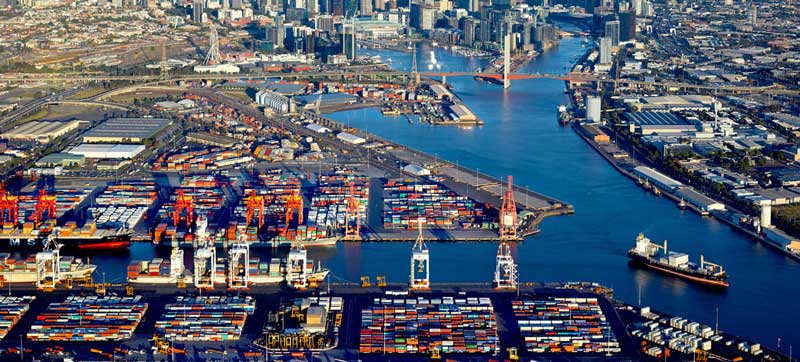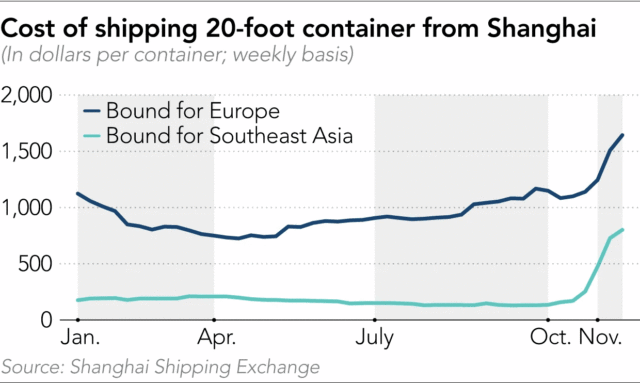Massive increases in air and seas freight due to the impacts of Covid will see price pressure on all imported photographic products in early 2021.

While products such as camera bags and tripods, and heavier items like lighting rigs and photographic paper are shipped by container, light-weight, high-value products such as cameras and lenses are generally exported to Australia via air freight, with a significant proportion on passenger flights. The virtual cessation of passenger services to Australia over an extended period has forced importers to rely more heavily on sea freight.
This has had a knock-on effect on container shipments, with ports ‘from Los Angeles to Sydney the busiest they have been all year’ according to Tim Morris, UK Major Ports Group, in an interviewed with the BBC World Service.
Earlier this year demand collapsed due to the lockdowns and store closures, with requests from retailers and distributors to delay cargo in transit. Now, in the run up to peak trading, demand for containers and space on the ships has rebounded – pushing the supply chain to breaking point.
In the same BBC segment Peter Wilson, MD of US shipping group Corey Brothers, said the cost of the use of shipping containers had increased up to 400 percent.
‘One of the biggest elements of the cost of any consumer good is shipping,’ he said, and these ‘vast increases’ will unavoidably put pressure on prices.
 As of mid-November, the cost to ship a 20-foot container from Shanghai to Singapore was around US$802, up 370 percent from $170 a month previous, according to data released by the Shanghai Shipping Exchange and reported in Nikkei Asia.
As of mid-November, the cost to ship a 20-foot container from Shanghai to Singapore was around US$802, up 370 percent from $170 a month previous, according to data released by the Shanghai Shipping Exchange and reported in Nikkei Asia.
Local prices to rise
Malcolm Kennedy, managing director of Australia’s largest independent photo goods distributor, CR Kennedy & Co, shared some local shipping rate information with Inside Imaging. The increase pre-Covid to now is 123 percent for container shipping ex-Singapore to Australia, and 205 percent for air freight.
‘This crisis is affecting the whole industry,’ he said ‘Due to Covid -19, there has been a huge increase in air and sea freight costs. Air because passenger flights have ceased, and the airlines are gouging on what few freight flights there are.
‘Sea because of the flow on from a lack of air freight and because of a worldwide massive shortage of containers, particularly from China.
‘We have seen the freight component on some shipments as high as 20 percent,’ he said.
He flagged an across-the-board increase of 5 percent in wholesale prices from CR Kennedy from January 1.
The disrupted international shipping networks – along with increased demand for containers due to lack of air freight services – has meant that instead of being ready to be loaded at ports of origin, containers are sitting empty at warehouses and ports of entry.
All these factors have combined to create a ‘perfect storm’ for the freight industry.
Jeff Servaas, managing director of Protog, which imports a range of professional lighting and other accessories mainly from China, agreed that the freight situation was indeed a crisis for the industry.
‘Airfreight has massively increased due to the shortage of planes coming into Australia,’ he explained. ‘While borders are not open to tourism, not many planes are flying to/from Australia. Sea freight costs have also risen.
‘Distancing restrictions on workers in transport are limiting how many people can work per shift on wharves and in warehouses, meaning more shift work needed, more penalty rates, and longer processing times for packing and unpacking at every point in the supply chain.
‘Add in the recent trade war where China has put a 212 percent tariff on Australian wine, and basically blocked the export of Australian timber, barley, and lobster so far, if it continues there is going to be a shortage of empty containers to bring freight to Australia, shipments are going to get more delayed, and more expensive to freight in 2021.
‘We haven’t formalised a price increase, but rising costs will force our hand sooner or later,’ he added.
Now Read: Chip fire to impact camera supply?





Be First to Comment